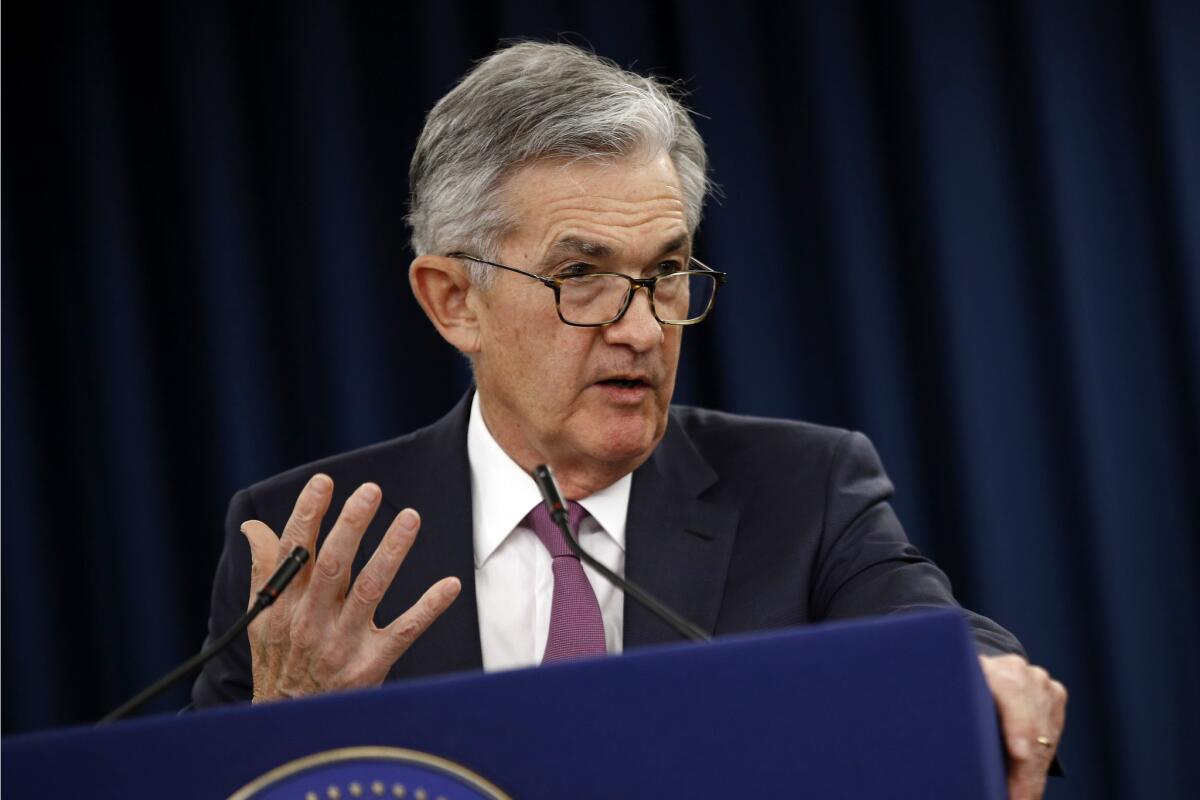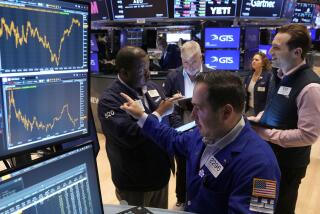Fed cuts interest rate for first time since 2008, adopting risky new strategy

WASHINGTON — The Federal Reserve on Wednesday cut interest rates for the first time since the Great Recession in 2008, a risky move that clashes with its historical practice of taking such a step only when the economy is in real trouble.
The small, quarter-point reduction in its key rate is meant to be preventive medicine in the face of global economic uncertainties, such as the U.S. trade conflict with China and Britain’s messy exit from the European Union.
In announcing its decision after a two-day meeting, the Fed highlighted elements of a solidly growing American economy but stated that it was acting “in light of the implications of global developments for the economic outlook as well as muted inflation pressures.”
That strategy is a departure from the past when the central bank typically acted only after seeing actual evidence of an impending downturn.
The Fed statement Wednesday signaled that the central bank was prepared to cut rates further if needed, reiterating that it “will act as appropriate to sustain the expansion.”
But financial markets and one of the Fed’s most influential critics — President Trump — were disappointed. Stocks sold off upon release of the statement and kept sinking as Fed Chair Jerome H. Powell addressed a news conference afterward.
Some investors were looking for a bigger half-point cut, and many others had been betting on the Fed to lower rates further in the next few months. But two of 10 policymakers voted against Wednesday’s rate move, preferring to stand pat. And Powell spoke tentatively about future plans, and he pushed back against the idea that this was, as he put it, “the beginning of a lengthy cutting cycle.”
Trump has been hammering the Fed and Powell, whom the president nominated, to do more to stimulate the economy. Trump tweeted ahead of the policymakers’ meeting that “a small rate cut is not enough.” And he kept up the pressure Wednesday after the Fed’s decision was announced.
“What the Market wanted to hear from Jay Powell and the Federal Reserve was that this was the beginning of a lengthy and aggressive rate-cutting cycle which would keep pace with China, The European Union and other countries around the world,” Trump tweeted. “As usual, Powell let us down.”
Powell kept a stiff upper lip when asked by a reporter about Trump’s influence, saying that political considerations have no bearing on the Fed’s decision.
But some analysts were unconvinced. And Powell came under renewed criticism from the other side of the rate debate — economists, investors and others who have argued that the central bank has no business cutting rates when the economy is humming.
“The Fed’s decision today is like in the days when doctors bled their patients to heal them,” said Chris Rupkey, managing director at MUFG Bank in New York. “Fed officials made a very unwise decision today and buckled to the president’s demands by manufacturing reasons to cut interest rates despite a strong economy with no recession signs apparent anywhere out on the horizon.”
Powell defended Wednesday’s decision as prudent risk-management. And he insisted that the small rate cut — and all the communications leading up to it that made it a sure thing — had boosted the economy.
Partly for that reason, the economic effect of Wednesday’s drop in the Fed’s benchmark rate to 2.25% from 2.5% will almost certainly be muted.
Mortgage rates and stock prices already have factored in a rate cut; most companies haven’t had trouble accessing capital; and tweaking borrowing costs won’t boost car sales, which have peaked after years of pent-up demand.
Credit isn’t what his company needs, said Greg Danenhauer, an owner of Parker Boiler, a 65-employee manufacturing company in Los Angeles. “We have money in the bank,” he said, although he noted that cheaper loans could help his small-business customers, which include breweries and laundry firms.
Wednesday’s Fed action also won’t mean much for savers who have socked away money in certificates of deposits. The average interest rate on five-year CDs, for example, already has dropped to 1.31% from 1.52% in March in anticipation of the Fed cut, said Greg McBride of Bankrate.com.
But the bigger, long-term danger is that with interest rates already low, dropping them further not only nicks the Fed’s firepower when a real downturn comes but also could add fuel to stocks and other assets that are at very high levels.
“That is clearly the risk: It fans some bubbles,” said Ryan Sweet, an economist at Moody’s Analytics.
In addition to lowering the Fed’s main overnight lending rate, officials said Wednesday that the central bank would halt its run-off of asset holdings in August, two months earlier than scheduled. Some observers, including a very critical Trump, had viewed that reduction of the Fed balance sheet as having a tightening effect.
Besides jawboning from Trump, who fears that a slowdown could hurt his chances of winning reelection next year, the Fed will almost certainly face pressure to lower rates further from markets as well.
It won’t be easy for Fed policymakers — who at times have given mixed or confusing communications — to manage Wall Street expectations.
Investors have been sensitive to every signal from the Fed, even if it involves just a small rate hike or cut. It reflects what analysts view as underlying insecurity in markets and an outsize reliance on the Fed to keep the party going.
The Fed in the past saw itself as a firefighter, but today it is more like a gardener that is expected to nurture an economy and keep it growing, said Dec Mullarkey, head of investment strategy at SLC Management, which manages $159 billion in assets.
And at the moment, the Fed is to trying to get ahead of a possible downturn as trade and other uncertainties have weighed on business sentiment and investments, he added.
“It’s an ounce of prevention is worth a pound of cure kind of move,” Mullarkey said.
He noted, however, that “it’s a dangerous game because markets now keep second-guessing you, and there’s quite a bit of feedback between markets and the Fed … You want the Fed to be leading that conversation, not reacting to it. And it’s complicated right now who’s doing what.”
Those pressures are, in part, of the Fed’s own making.
The central bank raised rates four times last year as the economy was rolling along, in a bid to wean the financial system from cheap money and return rates to more normal levels amid strong growth. But then Powell made an abrupt shift early this year, first pausing the rate-hike campaign and later in spring pivoting fully to a rate-cut bias.
U.S. economic fundamentals have remained solid during that period. While growth has slowed from about 3% last year and through the first quarter, that was expected. Among other things, stimulus from the big tax cut that passed in late 2017 began to fade.
Even then, second-quarter growth was a healthy 2.1% and forecasters see the rest of the year performing about as well.
The latest data on consumer spending were strong, lifted by resilient job growth and solid income gains. And inflation, which has been undershooting the Fed’s 2% target and gave policymakers another reason to cut rates, is poised to inch higher.
The Fed noted that business investment has been “soft,” and analysts attribute that partly to uncertainties stemming from the U.S.-China trade dispute and the multitude of tariffs imposed by each nation on the other. The two sides resumed negotiations this week but do not appear close to resolving their differences anytime soon.
Some economists, however, say the falloff in business spending for equipment and buildings is part of a cyclical slowdown and not an underlying threat to growth. And they don’t see the Fed having need to make further rate cuts after Wednesday.
In fact, the way things look now, the Fed could very well reverse course next year and push interest rates back up a notch, said Ken Matheny, an economist at Macroeconomic Advisers by IHS Markit, a leading forecasting firm in St. Louis.
Even though there is a case to be made for an “insurance cut” in rates, he said, financial conditions lately have become more favorable. And if the bipartisan budget that passed the House clears the Senate, as expected, that also could add a little more juice to growth in the second half.
“We think it’s a one-and-done,” Matheny said of Wednesday’s Fed action.
More to Read
Inside the business of entertainment
The Wide Shot brings you news, analysis and insights on everything from streaming wars to production — and what it all means for the future.
You may occasionally receive promotional content from the Los Angeles Times.











